-
Car Reviews
- All reviews
- Midsize SUVs
- Small cars
- Utes
- Small SUVs
- Large SUVs
- Large cars
- Sports SUVs
- Sports cars
- Vans
Latest reviews
- Car News
-
Car Comparisons
Latest comparisons
- Chasing Deals
The Subaru Outback has arrived in Australia in new sixth-generation form. There’s a simpler lineup, but the Outback preserves its practical wagon shape, but it does without the turbo engine many buyers want
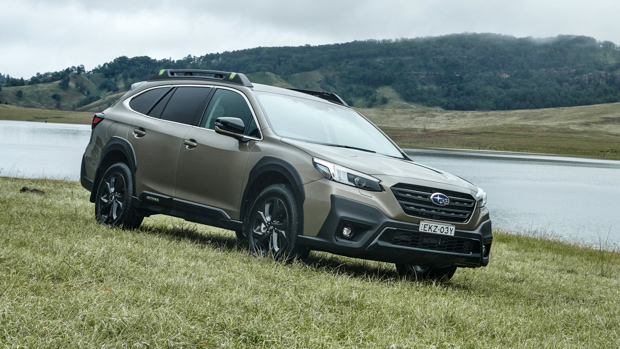
More than a year after it launched in North America, Subaru’s new Outback wagon has hit the Australian market.
For the most part, though, the 2021 Outback has been worth the wait. It shifts to a stiffer, better platform under the skin, and the new interior integrates modern tech – including a huge, Tesla-esque vertical touchscreen.
There are now three types of Outback to choose from across a simplified lineup. It’s still possible to get into an Outback for less than forty grand, with the new entry-level model – dubbed simply the Outback AWD – costing $39,990 before on-road costs.
From there, the choice is easy to understand. There’s the $44,490 Outback Sport AWD we’re testing here, which is aimed at the crowd that use their car to support outdoor sports. There’s an easy-clean water-repellant interior, heated seats, cross bars and a subtle exterior black pack with subtle green pops, plus satellite navigation.

Or, you can opt for an Outback with the lot. The $47,790 Outback Touring AWD replaces the outgoing 3.6R flagship grade, adding softer Nappa-grade leather to the mix, along with classy silver highlights outside. You also get a sunroof, Harman-Kardon stereo, and memory for the driver’s seat.
But while the new Touring AWD grade replaces the old Outback 3.6R, there’s no engine offered for 2021 that replaces that previous flagship’s six-cylinder powerhouse.
In fact, there’s just one engine – and for those seeking turbocharged torque or bigger-displacement refinement, Subaru Australia currently have no premium engine you can pay extra for.
Like the two other 2021 Outback variants, the Outback Sport uses a “90 per cent new” 2.5-litre naturally aspirated four-cylinder petrol engine.
The previous-gen Outback also offered a 2.5-litre four-cylinder, and while the new engine is fundamentally similar to the previous one, numerous parts are renewed and outputs rise just slightly – to 136kW of power and 245Nm of torque.
The petrol four-cylinder is connected to a permanent all-wheel-drive system via a conventionally variable (CVT) automatic – and that CVT is also about 80 per cent renewed, according to Subaru.
Buyers upgrading from the old Outback “2.5i” models will struggle to note much of a difference, though. The engine is slightly quieter and more refined, and the CVT has better artificial gear ‘stepping’ – but hard acceleration still feels elastic, a key characteristic of these sorts of automatics.

There’s no avoiding that the 2.5-litre petrol engine is merely adequate for the job at hand. At 1,629kg, the new Outback isn’t exactly light and 245Nm of torque at 3,400rpm does not translate to any meaningful shove under hard acceleration.
There is no doubt that the Volkswagen Passat Alltrack – which uses a two-litre turbo petrol engine with 169kW of power and 350Nm of torque – or its cousin, the Skoda Superb Scout, which makes 200kW of power and 350Nm of torque – feel much faster and require greater strain to build speed.
The deletion of the outgoing turbo diesel and six-cylinder petrol engines feels like a mistake, which could have been rectified by Subaru Australia ensuring the availability of the new Outback XT turbo models available in other markets.
The new Outback XT, sold in North America, uses a 2.4-litre turbo petrol four-cylinder to produce 194kW of power and 375Nm torque – much more generous numbers. Subaru Australia says they’re looking at whether they can bring the turbo here – but it should have been locked in from launch.
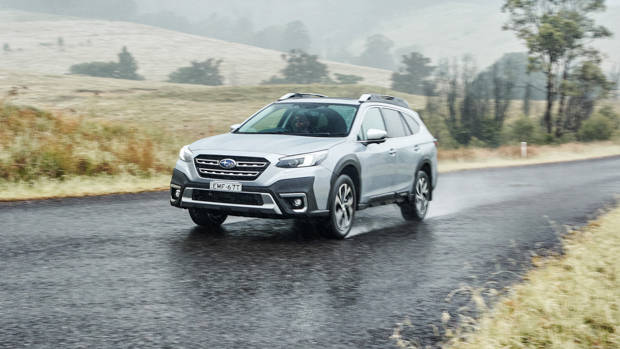
It’s a shame, because the new Outback’s chassis is more than capable of handling (much) more power. This car handles with reasonable agility and rides very well indeed.
The front end has considerably more bite when directed into a corner. This is partially a byproduct of the Outback’s shift to Subaru’s stiffer new Global Platform (SGP) architecture, and partially because Subaru Australia have finally specified the Outback with grippier tyres.
Just as they do on the BMW X3 and Toyota RAV4, the Bridgestone Alenza crossover tyres fitted to the new Outback perform quite well under load.
The ride is even better than the previous, fifth-gen Outback, which was soft but also lumpy and poorly controlled at times. Gone is the bobbing float of the old car, replaced by a really well balanced suspension that provides excellent urban comfort while retaining good body control at higher speeds on country roads.
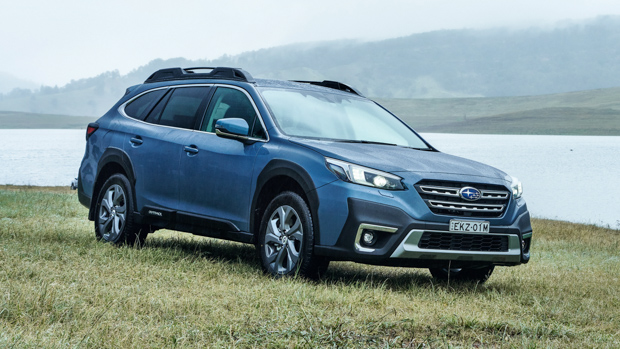
Hence why we think a quicker, torquier Outback turbo would be a good fit for Australia!
Refinement levels are also good in the new Outback, with low amounts of road and wind noise, while vibrations and general harshness are well insulated from the cabin.
Subaru have become known through the last decade for their focus on safety technologies – arguably, safety have replaced rally car for the road dynamics for this badge – and the new Outback picks up the company’s latest suite.
You get autonomous emergency braking on all models, including a reversing AEB function – impressive. The Outback also packs in camera-driven lane centring, speed sign recognition, and adaptive cruise control.
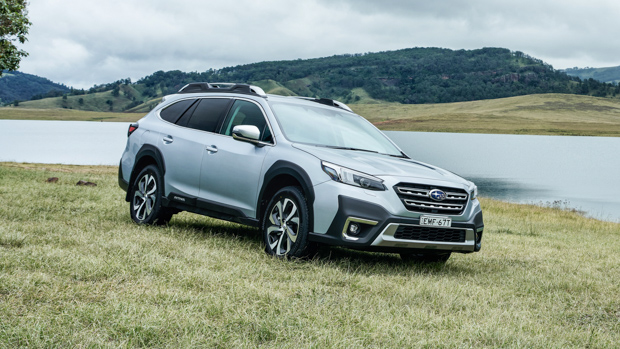
Just as on the outgoing Outback, Subaru’s safety systems are among the most sensitive in the industry, though we did notice the number of ‘false positive’ detections from the forward collision warning system have decreased generation-over-generation.
That said, while the Subaru systems are sensitive, there are some brands who deliver superior lane centring systems: the new Kia Sorento or Hyundai Santa Fe find and keep the centre of their lane more strongly when the system is engaged.
Most cars that wear ‘Sport’ nomenclature are all about sporty driving. Not the Outback Sport – in this case, it’s about the activities you’ll do with the car.
The Sport variant is the Outback to buy if you’re genuinely going to use the car to get to the trailhead for a mountain bike ride or hit the ski slopes. If you want a comfortable but very durable interior, this is the Outback to buy.
Compared to the base model’s cloth interior – or the posh Touring’s Nappa leather – the Outback Sport packs a more resilient water-repellent, almost neoprene-esque upholstery that will let you wipe down any mud or dirt without worrying about staining.
Despite their hard-wearing upholstery the seats still feel pretty good, and the comfortable, supportive shape of the front pews mean that long drives will leave you feeling refreshed. There is a good range of electric adjustment for both the driver and passenger, and both front seats are heated.
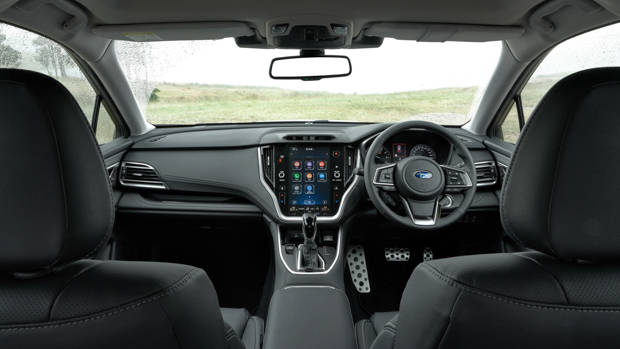
The Outback Sport also carries the green-flecked theme of the exterior inside, with green stitching found on the door and dashboard trimmings and the seats. Some of the stitching inside is white, though – not sure why the whole job wasn’t done in verdant green.
While the steering wheel and instrument cluster are essentially carried over from the old Outback, upgrading buyers will notice a big change in the touchscreen department.
Standard across the range is an 11-inch vertically-oriented touchscreen certainly inspired by that used in the Tesla Model S and Model X, even if the functionality isn’t quite as in-depth as those electric vehicles.
Subaru’s own software is reskinned and reconfigured to suit the vertical layout, and on the whole, it’s reasonably snappy and easy to use. Glare from the sun partially washes out the display but it’s always readable to some degree, and the navigation standard on the Sport and Touring grades is simple to input to and receive commands from.
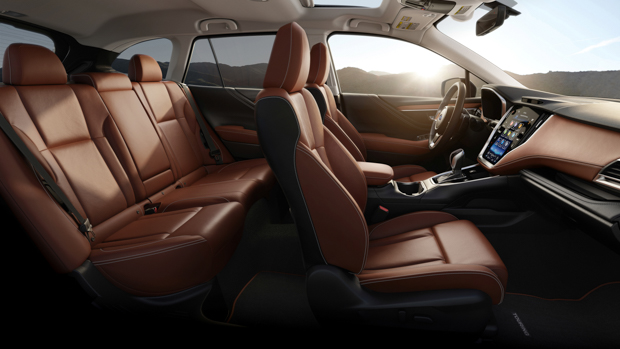
Unfortunately, this tan interior isn’t available in Australia.
Pity the stereo on the base grade and the Sport is very average indeed and way too bass-heavy. Those that enjoy clearer renditions of their favourite tracks will do well to upgrade to the Touring, which uses a premium Harman-Kardon sound system.
A further change to the Outback’s interior layout deletes the secondary trip computer screen from the top of the dash: the fuel economy, navigation, current track and other data that screen once provided has been moved to the small digital screen between the analogue gauges. No full digital cluster, akin to the Passat Alltrack or Superb Scout, is available.
We never had any concerns about interior build quality in the previous Outback, and this virtue carries across to the new car despite the platform switch. This is still a well-made, quality vehicle that is screwed together with precision. Tight panel fitment joined with no audible rattles or creaks to make the new Outback feel like a quality machine.
High quality also extends to the materials used throughout the Outback’s interior, which, on the whole, are plush and yielding pretty much everywhere: on the dash, the door trims, where your leg comes to rest, and on the armrest. This is a good, comfy road-trip car.
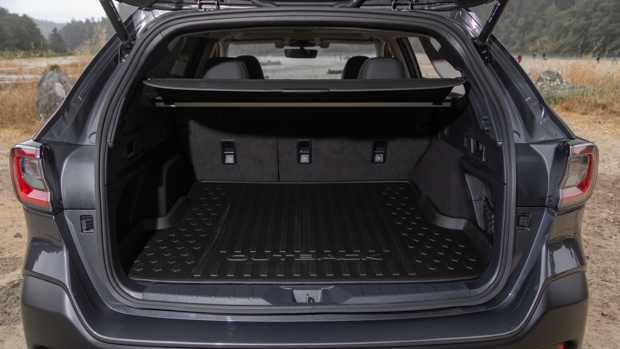
The back seat is still commodious, too. In particular, the rear seat bench is inclined enough to actually support the legs of those travelling in the back – something the Toyota RAV4 cannot claim. Plus, the standard presence of big air vents and two USB charge ports in the rear row are important inclusions.
A rear armrest incorporates two cup holders, but they’re shallow coffee-cup keepers: tall water bottles will fall out – but each door can accept a bottle.
Boot space is pretty good, too. Behind an electric tailgate – that moves promptly and without beeping – the new Outback has a 522 litre boot. That’s not quite as much as the Volkswagen Passat Alltrack, but the Subaru still has a big, square, usable space where you can store several large suitcases.
In the boot you’ll also find handles to remotely drop the rear seatbacks, which is handy – plus, like the Passat Alltrack, there is a full size spare tyre as well. And on the roof, the Outback continues to offer roof racks with integrated crossbars.
The Subaru Outback is reasonably affordable to run – this wagon is quite fuel efficient, and Subaru have worked to make servicing the new Outback less expensive.
Given there’s now only one engine, the service interval for every 2021 Outback is the same: 12 months or 12,500km. Some rivals can travel 15,000km between services – so the Subaru is slightly less convenient
Subaru publish their service pricing for the Outback, though it is subject to change in future. You aren’t able to purchase a prepaid service plan unlike some vehicles, but we have an idea of what it will cost to maintain the 2021 Outback.
The first five services – up to 5 years or 60,000km – are priced at $345, $595, $351, $801 and $358 respectively, for a three year total of $1,291, or a five year total of $2,450. That’s fairly lineball for this class, though the limit of 60,000km is quite low for a family car designed to do long distances.
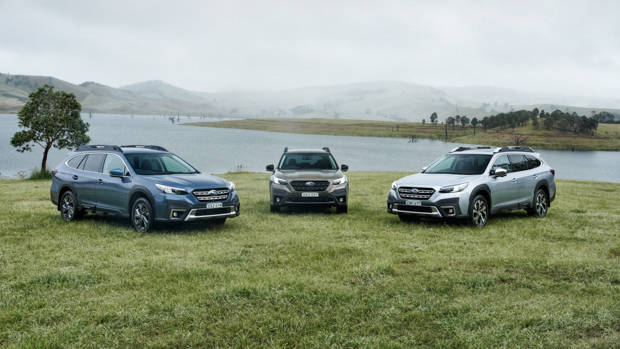
On the fuel consumption front, the Outback is reasonably frugal. Subaru say the Sport AWD uses 7.3L/100km. In reality, we found that the 2021 Subaru Outback with the 2.5-litre petrol engine consumed about 9L/100km when driven moderately. That’s pretty good.
However, unlike many European rivals, the Outback will accept the cheapest 91-octane petrol.
Like other Subaru products, the Outback is covered under a five year, unlimited kilometre warranty.
Even without the vaunted turbocharged petrol engine option available overseas, the Subaru Outback is a very accomplished family car.
The new model rides and handles better than the previous version. It’s also a handsome vehicle with an even better interior that incorporates some really modern tech.
That said, it’s dynamically held back by its engine, which is merely adequate rather than interesting in any way.
Subaru would do well to respond to clear consumer feedback, and bring the Outback turbo to Australia as soon as they can.
Until then, though, if you just need a reliable, comfortable, classy family wagon – the Outback deserves a very close look.
Variant tested AWD SPORT
Key specs (as tested)
About Chasing cars
Chasing Cars reviews are 100% independent.
Because we are powered by Budget Direct Insurance, we don’t receive advertising or sales revenue from car manufacturers.
We’re truly independent – giving you Australia’s best car reviews.
The estimate provided does not take into account your personal circumstances but is intended to give a general indication of the cost of insurance, in order to obtain a complete quote, please visit www.budgetdirect.com.au. Estimate includes 15%^ online discount.
^Conditions Apply
Budget Direct Insurance arranged by Auto & General Services Pty Ltd ACN 003 617 909(AGS) AFSL 241 411, for and on behalf of the insurer, Auto & General Insurance Company Limited(ABN 42 111 586 353, AFSL 285 571).Because we don’t know your financial needs, we can’t advise you if this insurance will suit you. You should consider your needs and the Product Disclosure Statement before making a decision to buy insurance. Terms and conditions apply.
Indicative quote based on assumptions including postcode , 40 year old male with no offences, licence suspensions or claims in the last 5 years, a NCD Rating 1 and no younger drivers listed. White car, driven up to 10,000kms a year, unfinanced, with no modifications, factory options and/or non-standard accessories, private use only and garaged at night.
^Online Discounts Terms & Conditions
1. Discounts apply to the premium paid for a new Budget Direct Gold Comprehensive Car Insurance, Third Party Property Only or Third Party Property, Fire & Theft Insurance policy initiated online on or after 29 March 2017. Discounts do not apply to optional Roadside Assistance.
2. Discounts do not apply to any renewal offer of insurance.
3. Discounts only apply to the insurance portion of the premium. Discounts are applied before government charges, taxes, levies and fees, including instalment processing fees (as applicable). The full extent of discounts may therefore be impacted.
4. We reserve the right to change the offer without notice.